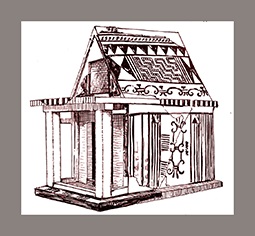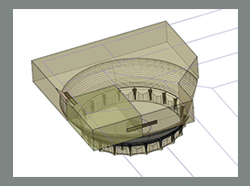Autore: A. Pierattini
Scarica l’articolo in formato .pdf: L’estetica del tempio greco prima degli ordini architettonici
 Con poche eccezioni, gli studi sull’architettura greca hanno interessato l’estetica dell’architettura prearcaica solo tangenzialmente, spesso associati alla ricerca delle origini del repertorio formale degli ordini architettonici dorico e ionico, le cui prime testimonianze note si datano alla seconda metà del VII secolo a.C. Questo contributo si concentra invece sull’estetica dell’architettura prearcaica nel suo contesto specifico. Esaminati qui in particolare sono gli edifici sacri, che già a partire dalla fine dell’VIII a.C. secolo iniziano a distinguersi dal resto dell’architettura per dimensioni e a mostrare una particolare elaborazione visiva attraverso la decorazione. L’orizzonte cronologico considerato comprende l’VIII secolo a.C., periodo in cui le testimonianze dell’architettura religiosa greca iniziano a moltiplicarsi rapidamente, e la prima metà del VII, la fase cruciale in cui i primi esperimenti nella costruzione in pietra e terracotta iniziano a trasformare l’immagine del tempio. Passando in rassegna le principali testimonianze archeologiche, il contributo si interroga sul trattamento delle superfici architettoniche, sull’importanza estetica delle colonne lignee e della copertura, e sull’impatto radicale e permanente dell’invenzione delle tegole laterizie sull’immagine del tempio.
Con poche eccezioni, gli studi sull’architettura greca hanno interessato l’estetica dell’architettura prearcaica solo tangenzialmente, spesso associati alla ricerca delle origini del repertorio formale degli ordini architettonici dorico e ionico, le cui prime testimonianze note si datano alla seconda metà del VII secolo a.C. Questo contributo si concentra invece sull’estetica dell’architettura prearcaica nel suo contesto specifico. Esaminati qui in particolare sono gli edifici sacri, che già a partire dalla fine dell’VIII a.C. secolo iniziano a distinguersi dal resto dell’architettura per dimensioni e a mostrare una particolare elaborazione visiva attraverso la decorazione. L’orizzonte cronologico considerato comprende l’VIII secolo a.C., periodo in cui le testimonianze dell’architettura religiosa greca iniziano a moltiplicarsi rapidamente, e la prima metà del VII, la fase cruciale in cui i primi esperimenti nella costruzione in pietra e terracotta iniziano a trasformare l’immagine del tempio. Passando in rassegna le principali testimonianze archeologiche, il contributo si interroga sul trattamento delle superfici architettoniche, sull’importanza estetica delle colonne lignee e della copertura, e sull’impatto radicale e permanente dell’invenzione delle tegole laterizie sull’immagine del tempio.
With only a few exceptions, the scholarship on Greek architecture has addressed the aesthetic of pre Archaic architecture only to a limited extent and often with the purpose of tracing the origins of Doric and Ionic forms and conventions that are documented later, beginning in the second half of the 7th century. Taking a different perspective, this article addresses the aesthetic of pre Archaic Greek architecture in its own context. It focuses on sacred buildings, which beginning at the end of the 8th century B.C. started to differentiate themselves from other buildings for their conspicuous size as well as for their decoration. The chronological scope of this article includes the 8th century B.C., when the evidence of sacred architecture increases dramatically in the Greek world, and the first half of the 7th, when the first experiments with cut stone and terracotta construction began to transform the appearance of the temple. Based on a review of the archaeological evidence, the article examines the treatment of architectural surfaces, the aesthetic importance of wooden columns and the roof, and the radical impact of terracotta roof tiles on the aesthetic of the temple.

